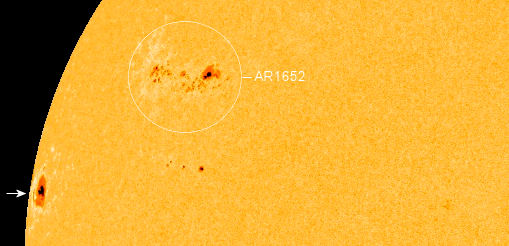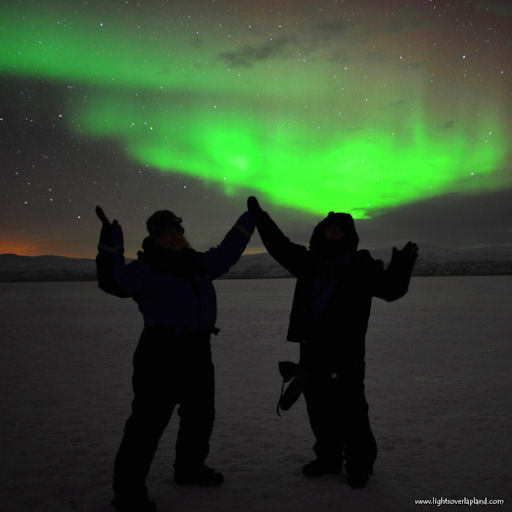Metallic photos of the sun by renowned photographer Greg Piepol bring together the best of art and science. Buy one or a whole set. They make a stellar gift. | | |
CHANCE OF FLARES: NOAA forecasters estimate a 35% chance of M-class flares and a 5% chance of X-flares during the next 24 hours. The most likely source would be sunspot AR1652; it has a 'beta-gamma' magnetic field that harbors energy for M-class eruptions. The active region is circled in this Jan. 8th image from NASA's Solar Dynamics Observatory:

Of greater interest, perhaps, is the large sunspot emerging just south of AR1652. Denoted by an arrow, the unnumbered region is crackling with C-class solar flares and, based on its size, could be capable of even stronger eruptions. We will know more in the days ahead as the sunspot turns toward Earth; a more direct view will reveal what kind of magnetic field the sunspot posseses. Solar flare alerts: text, voice.
Realtime Space Weather Photo Gallery
AURORA WATCH: Mild but effective gusts of solar wind are buffeting Earth's magnetic field, sparking auroras around the Arctic Circle. Last night in Abisko National Park, Sweden, aurora tour guide Chad Blakley received a grand display for his clients:

"Tonight was the first night of our January Aurora Photo Expedition and I am happy to report that all eight of our guests were able to see and photograph a very nice aurora display in the skies above Abisko National park," says Blakeley. "The lights started around 7:00 PM and continued to dance in the sky until we were all too tired to carry on. We are hopeful that the next few days will continue to impress!"
He could get his wish. A minor stream of solar wind flowing from a hole in the sun's corona is due to hit Earth's magnetic field on Jan. 9-10, producing a display to keep the tour guides busy. Aurora alerts: text, voice.
Realtime Aurora Photo Gallery
Realtime Meteor Photo Gallery
Realtime Noctilucent Cloud Photo Gallery
[previous years: 2003, 2004, 2005, 2006, 2007, 2008, 2009, 2011]
Potentially Hazardous Asteroids (
PHAs) are space rocks larger than approximately 100m that can come closer to Earth than 0.05 AU. None of the known PHAs is on a collision course with our planet, although astronomers are finding
new ones all the time.
On January 8, 2013 there were potentially hazardous asteroids.
Notes: LD means "Lunar Distance." 1 LD = 384,401 km, the distance between Earth and the Moon. 1 LD also equals 0.00256 AU. MAG is the visual magnitude of the asteroid on the date of closest approach. | | The official U.S. government space weather bureau |
| | The first place to look for information about sundogs, pillars, rainbows and related phenomena. |
| | Researchers call it a "Hubble for the sun." SDO is the most advanced solar observatory ever. |
| | 3D views of the sun from NASA's Solar and Terrestrial Relations Observatory |
| | Realtime and archival images of the Sun from SOHO. |
| | from the NOAA Space Environment Center |
| | the underlying science of space weather |

